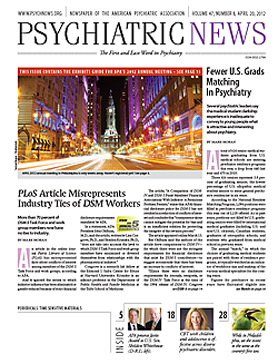An article in the online journal Public Library of Science (PLoS) has misrepresented facts about conflicts of interest among members of the DSM-5 Task Force and work groups, according to APA.
And it ignored the extent to which industry influence has been eliminated or greatly reduced because of strict financial disclosure requirements mandated by APA.
In a statement, APA President John Oldham, M.D., said the article, written by Lisa Cosgrove, Ph.D., and Sheldon Krimsky, Ph.D., “does not take into account the level to which DSM-5 Task Force and work group members have minimized or divested themselves from relationships with the pharmaceutical industry.”
Cosgrove is a research lab fellow at the Edmond J. Safra Center for Ethics at Harvard University. Krimsky is an adjunct professor in the Department of Public Health and Family Medicine at the Tufts School of Medicine
The article, “A Comparison of DSM-IV and DSM-5 Panel Members’ Financial Associations With Industry: A Pernicious Problem Persists,” states that APA’s financial disclosure policy for DSM-5 has not resulted in a reduction of conflicts of interest and concludes that “transparency alone cannot mitigate the potential for bias and is an insufficient solution for protecting the integrity of the revision process.”
The article appeared online March 13.
But Oldham said the authors of the article drew comparisons to DSM-IV—for which there were not the stringent requirements for financial disclosure that exist for DSM-5 contributors—to suggest erroneously that there has been an increase in conflicts of interest.
“[S]ince there were no disclosure requirements for journals, symposia, or the DSM-IV Task Force at the time of the 1994 release of DSM-IV, Cosgrove and Krimsky’s comparison of DSM-IV and DSM-5 Task Force and work group members is not valid,” Oldham said. “In assembling DSM-5 ’s Task Force and work groups, APA’s Board of Trustees developed an extensive process of written disclosure of potential conflicts of interest. These disclosures are required of all professionals who participate in the development of DSM-5. An independent APA committee reviews these disclosure documents, which are updated annually or whenever a member’s financial interests change.”
Oldham’s response noted that currently, 72 percent of the 153 members reported no relationships with the pharmaceutical industry during the previous year. Moreover, the scope of the relationships reported by the remaining 29 percent varies:
12 percent reported grant support only, including funding or receipt of medications for clinical trial research.
10 percent reported paid consultations including advice on the development of new compounds to improve treatments.
7 percent reported receiving honoraria.
These figures contradicted those cited by Cosgrove and Krimsky, who wrote, “Currently, 69 percent of the DSM-5 task force members report having ties to the pharmaceutical industry.”
They went on to add, “This represents a relative increase of 21 percent over the proportion of DSM-IV Task Force members with such ties (57 percent of DSM-IV task force members had ties).”
When queried for a response to APA’s challenge to the PLoS article, Cosgrove said their data for DSM-IV were “based on objective information we obtained from published sources since DSM did not disclose at that time the financial interests of panel members.”
She added, “We used the same methodology in the current study although the sources of information were different because DSM-5 did a lot of work for us by disclosing the financial ties.”
With regard to the apparent discrepancy in reported industry ties, Cosgrove said in her response that the figures she derived for the DSM-5 group include the full three-year period prior to each person’s nomination to the task force or work group, as was required for participation in DSM-5.
She added, “It is important in reporting financial interests that one chooses a time period prior to the publication of the document. Thus, in order to compare the commercial ties of the DSM-IV and DSM-5 groups, we relied on the best available data for each group: published disclosures (for example, in peer-reviewed medical journals) of financial ties for DSM-IV and the disclosure forms for the DSM-5 groups.”
But Darrel Regier, M.D., M.P.H, APA’s director of research, said that using the entire three-year reporting data and presenting the data as current ignores the degree to which DSM-5 reporting requirements have resulted in minimization or divestment of industry ties over time.
“As documented in their previous publications, these authors take the position that if there was ever any kind of relationship with the pharmaceutical industry, the clinician should be excluded from DSM-5 participation—an extreme position with which we disagree,” Regier told Psychiatric News. “As a result, they counted all disclosures for all years that were posted for DSM-IV Task Force members after 1994 publication of DSM-IV and contrasted that with DSM-5 Task Force member disclosures for three years prior to their appointment—without recognizing the substantial decrease in member affiliations as the DSM process progressed over five years.”
Regier added, “It is clear that there has been a sea change in how academic investigators related to industry over the past seven years since 2005—three years before the work group members were reviewed for their 2008 appointments to the DSM-5 Task Force. A good number of investigators were providing lectures at industry-sponsored symposia at the APA [annual meeting] and other meetings from 2005 to 2007, when those who were invited to participate in DSM-5 agreed to limit and often end such relationships.
“The use of the words ‘a pernicious problem persists’ in the headline is unfortunate and highly inaccurate,” Regier said. “The implication is that the relationships continue to exist as previously, when in fact there has been a marked drop in industry relationships—which the authors fail to recognize or acknowledge.”

